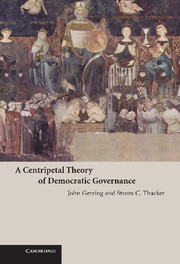Book contents
- Frontmatter
- Contents
- List of Figures
- List of Tables
- Acknowledgments
- A Centripetal Theory of Democratic Governance
- 1 Models of Governance
- PART ONE CAUSAL MECHANISMS
- 2 Party Government
- 3 Conflict Mediation
- 4 Policy Coordination
- PART TWO EMPIRICS
- PART THREE CONCLUSIONS
- Appendix A Defining Good Governance
- Appendix B Alternative Theories Revisited
- Sources
- Author Index
- Subject Index
4 - Policy Coordination
Published online by Cambridge University Press: 06 July 2010
- Frontmatter
- Contents
- List of Figures
- List of Tables
- Acknowledgments
- A Centripetal Theory of Democratic Governance
- 1 Models of Governance
- PART ONE CAUSAL MECHANISMS
- 2 Party Government
- 3 Conflict Mediation
- 4 Policy Coordination
- PART TWO EMPIRICS
- PART THREE CONCLUSIONS
- Appendix A Defining Good Governance
- Appendix B Alternative Theories Revisited
- Sources
- Author Index
- Subject Index
Summary
Government is often conceptualized as a solution to societal coordination problems. Yet the institutions of governance may also suffer from coordination problems. There are many variations on this theme – joint-decision traps, shirking, underproviding of public goods, overgrazing, the tragedy of the commons, common-pool problems, collective action problems, free-rider problems, prisoner's dilemmas, transaction-cost dilemmas, and so forth. These are different ways of pointing out a central problem: quite often, when individuals, groups, or institutions pursue their own agendas (even with the best of intentions), the result is not what members of society at large would prefer. Coordination problems thus involve a conflict between the part and the whole, between individual and collective rationality.
In this chapter, we are concerned specifically with policy coordination, that is, success in coordinating among a national government's constituent parts: between legislature and executive, between backbenchers and party leaders, among parties, among diverse agencies, between national and subnational governments, and among subnational governments. Successful coordination among these institutions can help resolve many of society's collective problems.
Centripetal theory suggests two solutions to this species of political problem. The first is Hobbesian: the internalization of externalities by centralizing jurisdictions and responsibilities. This has the effect of minimizing coordination problems because there are no independent (in the sense of sovereign) sources of power left to coordinate. They have all been incorporated.
- Type
- Chapter
- Information
- A Centripetal Theory of Democratic Governance , pp. 62 - 84Publisher: Cambridge University PressPrint publication year: 2008



